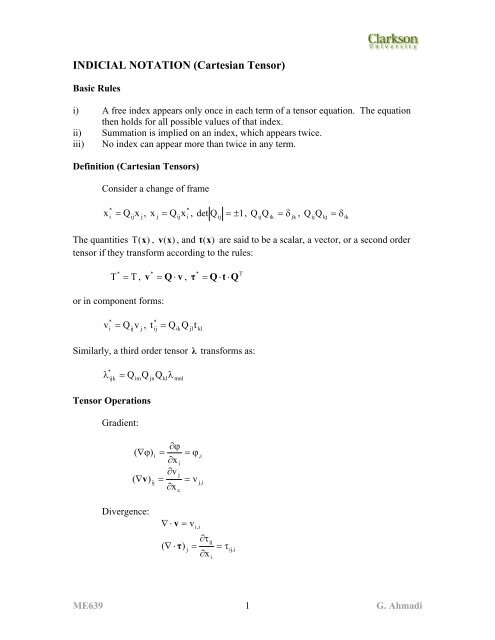INDICIAL NOTATION (Cartesian Tensor)
INDICIAL NOTATION (Cartesian Tensor)
INDICIAL NOTATION (Cartesian Tensor)
You also want an ePaper? Increase the reach of your titles
YUMPU automatically turns print PDFs into web optimized ePapers that Google loves.
<strong>INDICIAL</strong> <strong>NOTATION</strong> (<strong>Cartesian</strong> <strong>Tensor</strong>)<br />
Basic Rules<br />
i) A free index appears only once in each term of a tensor equation. The equation<br />
then holds for all possible values of that index.<br />
ii) Summation is implied on an index, which appears twice.<br />
iii) No index can appear more than twice in any term.<br />
Definition (<strong>Cartesian</strong> <strong>Tensor</strong>s)<br />
Consider a change of frame<br />
*<br />
*<br />
x<br />
i<br />
= Qijx<br />
j, x<br />
j<br />
= Qijx<br />
i<br />
, det Q<br />
ij<br />
= ± 1, QijQ ik<br />
= δ<br />
jk<br />
, Q<br />
ijQ kj<br />
= δik<br />
The quantities T(<br />
x ) , v (x)<br />
, and t(x)<br />
are said to be a scalar, a vector, or a second order<br />
tensor if they transform according to the rules:<br />
T * = T, v = Q ⋅ v , τ<br />
or in component forms:<br />
= Q ⋅t<br />
⋅Q<br />
* *<br />
T<br />
v = Q<br />
*<br />
i<br />
ij<br />
v<br />
j<br />
,<br />
t = Q<br />
*<br />
ij<br />
ik<br />
Q<br />
jl<br />
t<br />
kl<br />
Similarly, a third order tensor<br />
λ<br />
transforms as:<br />
λ<br />
*<br />
ijk<br />
= Q Q Q λ<br />
im<br />
jn<br />
kl<br />
mnl<br />
<strong>Tensor</strong> Operations<br />
Gradient:<br />
∂ϕ<br />
( ∇ϕ)<br />
i<br />
=<br />
∂x<br />
i<br />
∂v<br />
j<br />
( ∇v)<br />
ij<br />
=<br />
∂x<br />
ε<br />
= ϕ<br />
= v<br />
,i<br />
j,i<br />
Divergence:<br />
∇ ⋅ v<br />
=<br />
v i,i<br />
∂τij<br />
( ∇ ⋅ τ )<br />
j<br />
= = τ<br />
∂x<br />
i<br />
ij,i<br />
ME639<br />
1<br />
G. Ahmadi
Curl:<br />
∂U<br />
k<br />
( ∇ × U )<br />
i<br />
= εijk<br />
= εijk<br />
∂x<br />
j<br />
Here, ε<br />
ijk<br />
is the permutation symbol. The permutation symbol is used for<br />
evaluating the determinant. e.g.,<br />
det A = ε A A A ,<br />
ijk<br />
1i<br />
2 j<br />
3k<br />
U<br />
k, j<br />
The inner product of the permutation symbol satisfy the following identity:<br />
ε<br />
ijk<br />
ε<br />
imn<br />
= δ<br />
jm<br />
δ<br />
kn<br />
− δ<br />
jn<br />
δ<br />
km<br />
Laplacian:<br />
∇<br />
2<br />
ϕ =<br />
2<br />
∂ ϕ<br />
∂x<br />
∂x<br />
i<br />
i<br />
= ϕ<br />
,ii<br />
Isotropic <strong>Tensor</strong>s<br />
Isotropic tensors are tensors, which are form invariant under all possible rotations<br />
of the frame of reference. The most general forms of the isotropic tensors are:<br />
Rank zero: All scalars isotropic<br />
Rank one: None<br />
Rank two: αδij<br />
, α a scalar and δ<br />
ij<br />
= Kronec ker delta<br />
Rank three:<br />
αε<br />
ijk<br />
Rank four: αδ δ + β δ δ + δ δ ) + γ(<br />
δ δ − δ δ )<br />
ij<br />
kl<br />
(<br />
ik jl il jk ik jl il jk<br />
ME639<br />
2<br />
G. Ahmadi

















